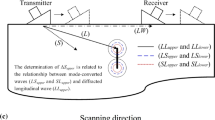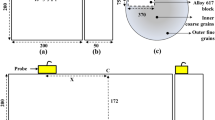Abstract
Ultrasonic time of flight diffraction (TOFD) suffers from the shortcoming of lack of near surface resolution, primarily owning to the superposition of the lateral wave and the shallow buried defect (SBD) wave, and the insensitive region beneath the inspection surface because of the restricted beam width of the probes. This paper presents a method for the detection of SBD based on conventional TOFD. The method is named as TOFDW because it employs a three-fold reflected longitudinal wave whose propagation path in the testing piece looks like the letter “W”. Based on Pythagoras’s theory, mathematical models are developed to locate SBD. In TOFDW mode, the time difference between the lateral wave and the SBD wave can be enlarged greatly so that they would never be superposed. In addition, through reflecting the incident longitudinal wave by bottom surface, the near surface region of the testing piece is covered with an intense acoustic field, making TOFDW free of the restriction of the probes’ beam width. These contribute to the improvement of the near surface resolution. The experiments show that with the proposed TOFDW and mathematical models, the artificial defect tip with the buried depth of 1 mm can be detected, and the tips can be measured within an error of 0.3 mm; the weld defect with the buried depth of 2 mm can be identified effectively, and the location can be measured within an error of 0.5 mm.













Similar content being viewed by others
References
Nath, S.K., Krishnan, B., Krishnamurthy, C.V., et al.: Reliability assessment of manual ultrasonic time of flight diffraction (TOFD) inspection for complex geometry components. NDT E Int. 43(2), 152–162 (2010)
Nath, S.K., Krishnan, B., Krishnamurthy, C.V., et al.: Sizing of surface breaking cracks in complex geometry components by ultrasonic time-of-flight diffraction (TOFD) technique. Insight 49(4), 200–206 (2007)
Baskaran, G., Balasubramaniam, K., Rao, C.L.: Shear-wave time of flight diffraction (S-TOFD) technique. NDT E Int. 39(6), 458–467 (2006)
Subbaratnam, R., Abraham, S.T., Venkatraman, B.: Immersion and TOFD (I-TOFD): a novel combination for examination of lower thicknesses. J. Nondestruct. Eval. 30(3), 137–142 (2011)
Veiga, J.L., Carvalho, A.A., Silva, I.C., et al.: The use of artificial neural network in the classification of pulse-echo and TOFD ultrasonic signals. J. Braz. Soc. Mech. Sci. Eng. 24(7), 394–398 (2005)
Elineudo, P.M., Romeu, R., Silva, M.H.S., et al.: Pattern recognition of weld defects in preprocessed TOFD signals using linear classifiers. J. Nondestruct. Eval. 23(4), 163–172 (2004)
Petcher, P.A., Dixon, S.: A modified Hough transform for removal of direct and reflected surface waves from B-scans. NDT E Int. 44(2), 139–144 (2011)
Gang, T., Chi, D.Z.: Novel approach to enhancement of ultrasonic TOFD B-scan image for measurement of weld crack. Sci. Technol. Weld. Join. 12(1), 87–93 (2007)
Baskaran, G., Balasubramaniam, K., Krishnamurthy, C.V., et al.: Ultrasonic TOFD flaw sizing and imaging in thin plates using embedded signal identification technique (ESIT). Insight 46(9), 537–542 (2004)
Chi, D.Z., Gang, T., Gao, S.S.: Background removal and weld defect detection based on energy distribution of image. China Weld. 16(1), 14–18 (2007)
Acknowledgements
The authors are grateful to the support of National Natural Science Foundation (51005056, 51175113), Natural Science Foundation of Heilongjiang Province (QC2010081), China Postdoctoral Special Science Foundation (201104416) and Specialized Research Fund for the Doctoral Program of Higher Education (20102302120045). The authors wish to express their appreciation to the reviewers for their helpful suggestions which greatly improved the presentation of the paper.
Author information
Authors and Affiliations
Corresponding author
Rights and permissions
About this article
Cite this article
Chi, D., Gang, T. Shallow Buried Defect Testing Method Based on Ultrasonic TOFD. J Nondestruct Eval 32, 164–171 (2013). https://doi.org/10.1007/s10921-012-0169-1
Received:
Accepted:
Published:
Issue Date:
DOI: https://doi.org/10.1007/s10921-012-0169-1




